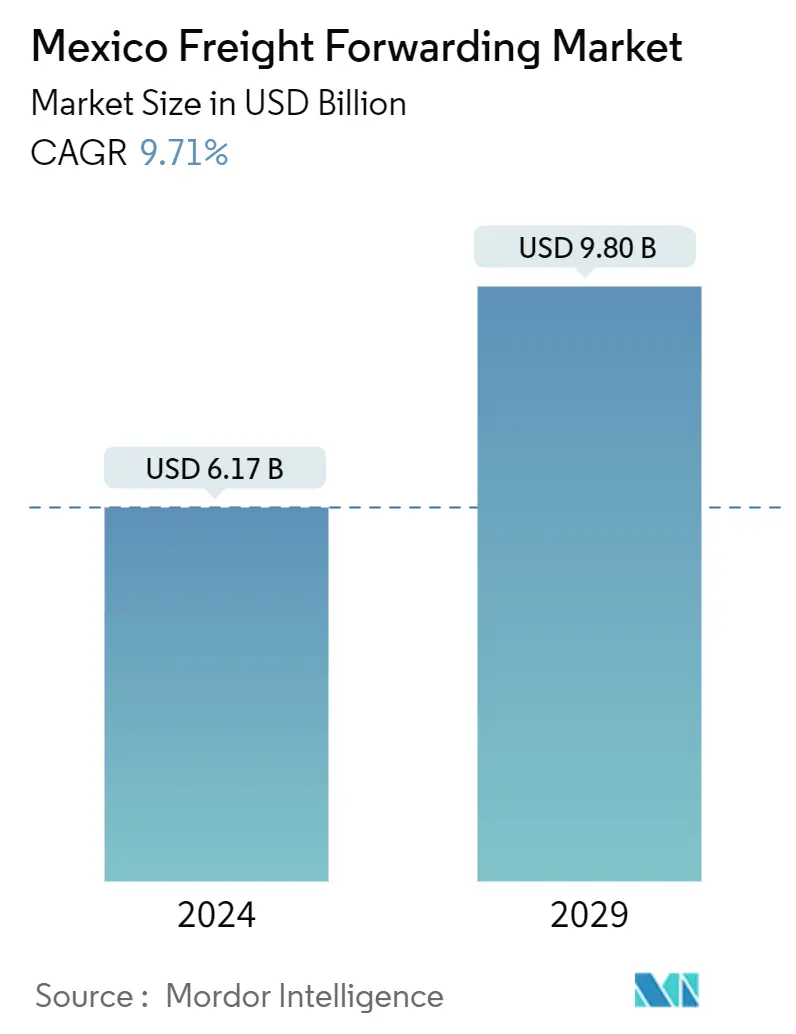Market Size of Mexico Freight Forwarding Industry

| Study Period | 2019-2028 |
| Base Year For Estimation | 2022 |
| Market Size (2024) | USD 6.17 Billion |
| Market Size (2029) | USD 9.80 Billion |
| CAGR (2024 - 2029) | 9.71 % |
| Market Concentration | Low |
Major Players
*Disclaimer: Major Players sorted in no particular order |
Mexico Freight Forwarding Market Analysis
The Mexico Freight Forwarding Market size is estimated at USD 6.17 billion in 2024, and is expected to reach USD 9.80 billion by 2029, growing at a CAGR of 9.71% during the forecast period (2024-2029).
- The increase in foreign trade drives the market. Furthermore, the market is driven by the growth of manufacturing and allied sectors in the country.
- Mexico is highly dependent on foreign trade, which represented 83.6% of its GDP in 2021 (World Bank, latest available data). The country mainly exports cars (14.3%), automatic data-processing machines (6.7%), vehicle parts (6.2%), petroleum oils (4.8%), and monitors and projectors (3.2%). As for imports, Mexico’s main purchases include parts and accessories for motor vehicles (5.1%), petroleum oils (4.9%), electronic integrated circuits (4.3%), petroleum gas (3.1%), and telephone sets (2.7%).
- According to Internal Monetary Fund (IMF) Foreign Trade Forecasts, the volume of exports of goods and services increased by 6.9% in 2022 and is expected to decrease by 0.5% in 2023, while the volume of imports of goods and services increased by 5.4% in 2022 and was expected to increase by 0.5% in 2023.
- The impulse that the government gives to foreign trade will give a natural boost to Mexican exports. In 2022, Mexico’s GDP amounted to approximately 1.47 trillion U.S. dollars. But, despite the optimistic outlook for foreign trade, the scenario is uncertain as many numbers are still tentative and, at times, disparate. In contrast to the 9% increase in exports predicted by COMCE for this year, the Economic Commission for Latin America and the Caribbean (ECLAC) predicts a rebound of up to 25% in the country’s exports.
- Mexican exports have become more competitive in comparison to its major export market and fellow NAFTA countries, which accounted for 81.2% of Mexico's total exports. The road sector was the most profitable in the transportation sector, accounting for approximately 91% of the entire transportation services industry value. NAFTA also solidified Mexico's trade links, with 84% of Mexican exports flowing to the United States and Canada.
- As a result, road freight accounts for the vast majority of the freight business. Mexico has risen to the top of the list of destinations for multinational corporations looking to establish manufacturing plants outside of Asia in the previous year. This situation, which is the inverse of offshore, is known as "nearshoring." This implies that businesses are gradually shifting a portion of their manufacturing to nations near their markets and with comparable time zones.
- The shift has been aided by the strong integration that exists between North American nations as a result of the T-MEC. This international agreement encourages trade between the markets of the United States, Canada, and Mexico. Mexico's unique location as an American nearshoring hub has made it an appealing choice for multinational corporations looking to expand their operations.
- Because of its proximity to the United States, the world's largest consumer market, the Latin American country is an excellent choice for firms looking to reduce shipping delays and transportation costs. Mexico has also used its favorable business environment to attract multinational firms eager to expand their operations. Recent trade agreements between the country and the United States and Canada have contributed to the development of the economy.
Mexico Freight Forwarding Industry Segmentation
Freight forwarding is the strategic planning and execution of logistics for the international movement of commodities on behalf of shippers. A freight forwarder, for example, will handle freight rate negotiations, container tracking, customs documentation, and freight consolidation, among other things.
The Mexico freight forwarding market is segmented by mode of transport (air freight forwarding, ocean freight forwarding, road freight forwarding, rail freight forwarding), by customer type (B2C and B2B), and by application (industrial and manufacturing, retail, healthcare, oil and gas, food and beverages and other application).
The report offers market size and forecast values (USD) for all the above segments.
| By Mode Of Transport | |
| Air Freight Forwarding | |
| Ocean Freight Forwarding | |
| Road Freight Forwarding | |
| Rail Freight Forwarding |
| By Customer Type | |
| B2B | |
| B2C |
| By Application | |
| Industrial And Manufacturing | |
| Retail | |
| Healthcare | |
| Oil And Gas | |
| Food And Beverages | |
| Other Applications |
Mexico Freight Forwarding Market Size Summary
The Mexico freight forwarding market is poised for substantial growth, driven by the country's strategic position as a hub for foreign trade and manufacturing. With a significant portion of its GDP reliant on international commerce, Mexico has become a key player in the global supply chain, particularly due to its proximity to the United States, the world's largest consumer market. The market is characterized by a robust demand for road freight services, which dominate the transportation sector, accounting for a major share of the industry's value. The integration of North American economies through agreements like T-MEC has further bolstered Mexico's appeal as a nearshoring destination, attracting multinational corporations seeking to optimize their manufacturing and distribution networks.
The competitive landscape of the Mexico freight forwarding market is marked by the presence of numerous local and international players, including major companies such as DHL, DB Schenker, and UPS. This fragmented market is witnessing increased competition, driven by mergers, acquisitions, and technological advancements. Recent investments, such as DHL's significant financial commitment to expand its operations in Mexico, underscore the market's potential for growth. The ongoing evolution of trade agreements and the dynamic nature of global trade continue to create opportunities for market participants, positioning Mexico as a pivotal player in the freight forwarding industry.
Mexico Freight Forwarding Market Size - Table of Contents
-
1. MARKET INSIGHTS DYNAMICS
-
1.1 Current Market Scenario
-
1.2 Market Overview
-
1.3 Market Dynamics
-
1.3.1 Drivers
-
1.3.2 Restraints
-
1.3.3 Opportunities
-
-
1.4 Value Chain / Supply Chain Analysis
-
1.5 Porter's Five Forces Analysis
-
1.5.1 Threat of New Entrants
-
1.5.2 Bargaining Power of Buyers/Consumers
-
1.5.3 Bargaining Power of Suppliers
-
1.5.4 Threat of Substitute Products
-
1.5.5 Intensity of Competitive Rivalry
-
-
1.6 Technological Advancements in Freight Forwarding
-
1.7 Digitalisation of Freight Forwarding Market
-
1.8 Pricing Analysis and Revenue analysis of Freight Forwarding Market
-
1.9 Impact of COVID-19 on the market
-
-
2. MARKET SEGMENTATION
-
2.1 By Mode Of Transport
-
2.1.1 Air Freight Forwarding
-
2.1.2 Ocean Freight Forwarding
-
2.1.3 Road Freight Forwarding
-
2.1.4 Rail Freight Forwarding
-
-
2.2 By Customer Type
-
2.2.1 B2B
-
2.2.2 B2C
-
-
2.3 By Application
-
2.3.1 Industrial And Manufacturing
-
2.3.2 Retail
-
2.3.3 Healthcare
-
2.3.4 Oil And Gas
-
2.3.5 Food And Beverages
-
2.3.6 Other Applications
-
-
Mexico Freight Forwarding Market Size FAQs
How big is the Mexico Freight Forwarding Market?
The Mexico Freight Forwarding Market size is expected to reach USD 6.17 billion in 2024 and grow at a CAGR of 9.71% to reach USD 9.80 billion by 2029.
What is the current Mexico Freight Forwarding Market size?
In 2024, the Mexico Freight Forwarding Market size is expected to reach USD 6.17 billion.

